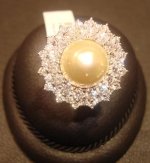olmander
New Member
But isn't it exactly what happened now? I read that natural pearl production practically does not exist anymore. Is it true?
I wonder how little average consumers know about what they are buying. One of the more or less knowledgible shop owners here around told me that Chinese production is literally killing the Japanese Akoya production. I was surprised: Akoya is Akoya and it is still dominated by Japan. But he said that people come and want just a nice stand whatever it is, and Chinese ones are of course cheaper. I happened to be the first customer in the last half-a-year who wanted precisely this and this and of this particular size and asked more questions than he could answer. Is not it a shame for such an interesting and exquisite market as pearls?
I wonder how little average consumers know about what they are buying. One of the more or less knowledgible shop owners here around told me that Chinese production is literally killing the Japanese Akoya production. I was surprised: Akoya is Akoya and it is still dominated by Japan. But he said that people come and want just a nice stand whatever it is, and Chinese ones are of course cheaper. I happened to be the first customer in the last half-a-year who wanted precisely this and this and of this particular size and asked more questions than he could answer. Is not it a shame for such an interesting and exquisite market as pearls?

